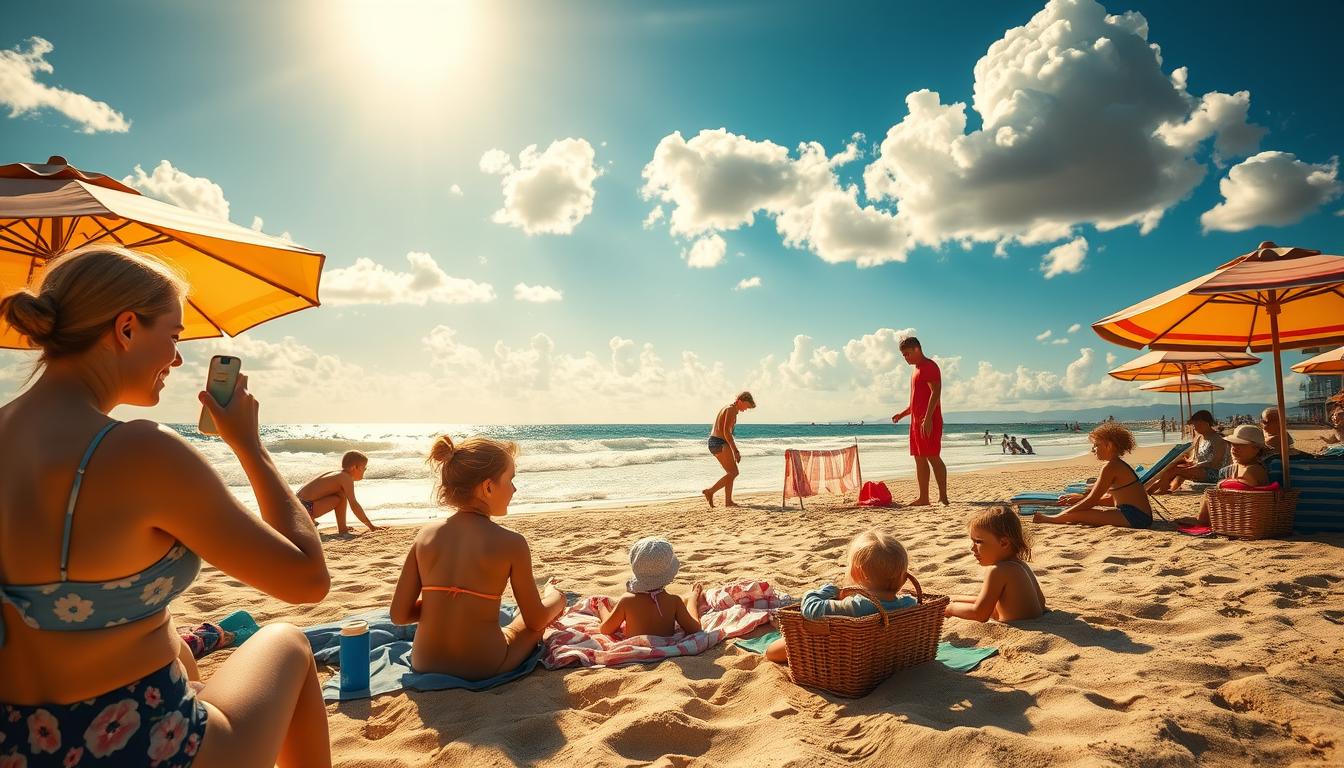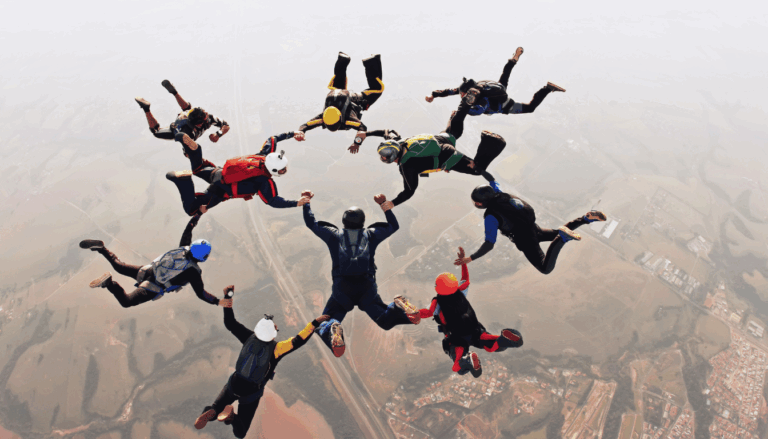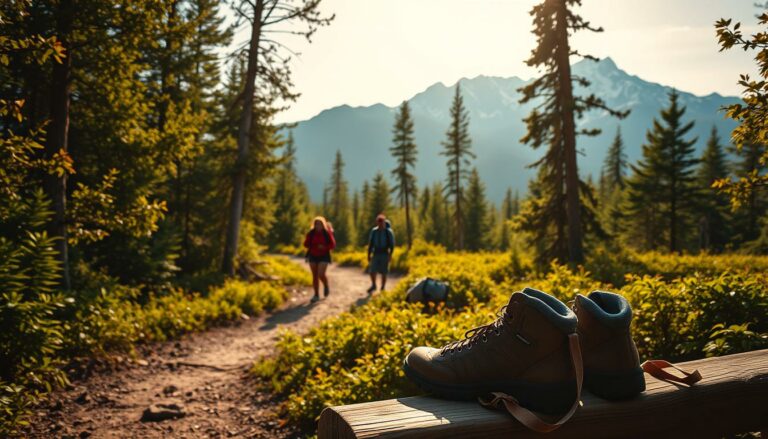Protect Yourself This Summer 2025: Safety Tips
As you dive into the summer season of 2025, it’s key to know the dangers. Enjoying the sun while keeping safe is vital.
We’ll share summer safety tips and guidelines to keep you safe. Learn about sun protection and water safety measures. You’ll know how to have fun while staying safe with your loved ones.
Key Takeaways
- Stay informed about weather conditions
- Use protective gear like sunscreen and hats
- Be cautious around water bodies
- Plan outdoor activities during safer hours
- Stay hydrated and avoid heat exhaustion
What’s New in Summer Safety for2025
Summer 2025 is here, and it’s time to refresh your safety knowledge. With the heat up, there’s a higher risk of heat-related illnesses and other summer health issues.
Emerging Summer Health Concerns
Summer 2025 brings new challenges, like a higher risk of heat exhaustion and heat stroke. It’s important to know the signs, such as:
- dizziness and nausea
- headaches and fatigue
- rapid heartbeat and low blood pressure
Staying hydrated is crucial to avoid these issues. Drink lots of water all day and avoid hard activities when it’s hottest.
Essential Safety Gear for the Season
Having the right safety gear is vital for a great summer. Some essential items include:
- Sunscreen with a high SPF rating
- A hat and sunglasses for extra protection
- Lightweight, breathable clothes
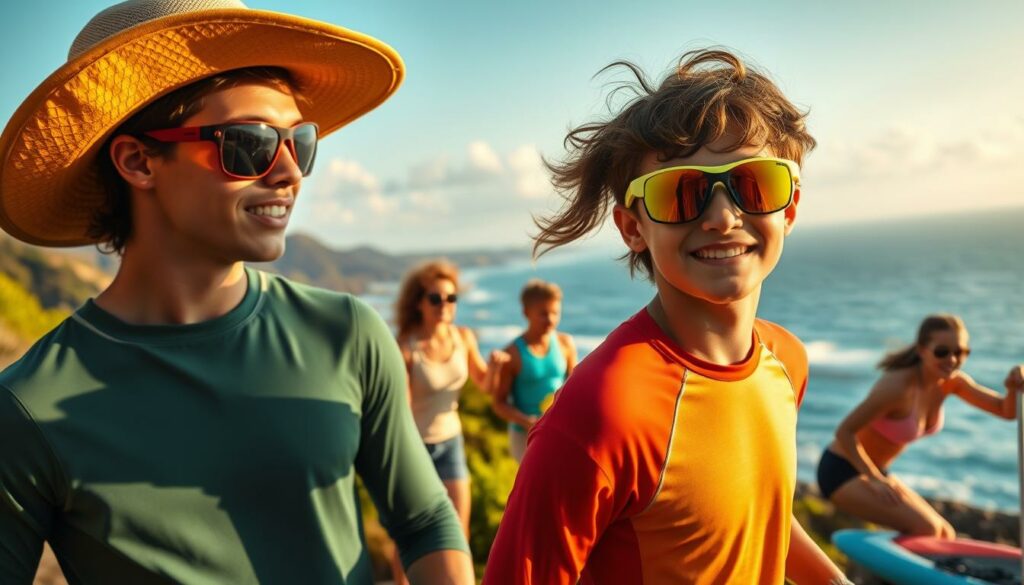
By knowing about new health concerns and having the right gear, you can have a safe and fun summer. Always stay updated on summer health tips and follow hot weather safety tips to keep yourself and your loved ones safe.
How to Shield Yourself from Harmful Sun Exposure
Protecting yourself from the sun’s harmful rays is key for a fun summer. Spending time outside means you need to know how to keep your skin safe.
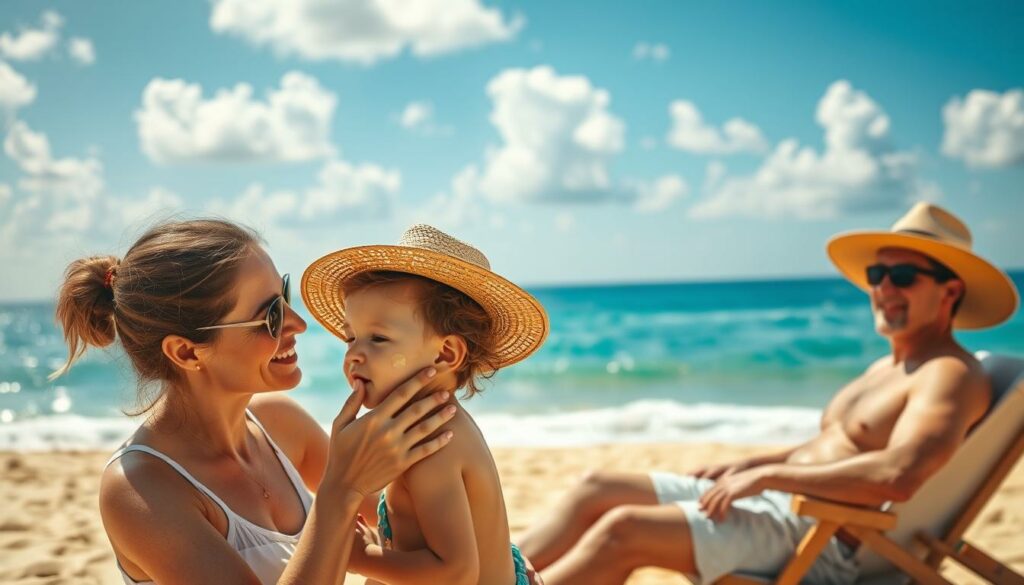
Selecting and Applying Sunscreen Properly
Choosing the right sunscreen is your first defense against the sun. Look for a broad-spectrum sunscreen with an SPF of at least 30. Apply it generously to all exposed skin 15 to 30 minutes before going outside. Don’t forget often-missed spots like the tops of your ears and the back of your neck.
Reapply sunscreen every two hours or right after swimming or sweating. Using a lip balm with SPF can also protect your lips from sun damage.
Protective Clothing Strategies
Wearing the right clothes can help a lot. Choose lightweight, loose-fitting clothes that cover your skin without making you too hot. A hat with a wide brim can protect your face, neck, and ears. Sunglasses with UV protection can also protect your eyes and the skin around them.
Planning Your Day Around UV Index
The UV index helps plan your outdoor time. Check the UV forecast before going out. Try to avoid the sun during peak hours, usually between 10 am and 4 pm. Seek shade when the sun is strongest, and plan strenuous activities for early morning or late afternoon.
By keeping an eye on the UV index and adjusting your plans, you can enjoy the outdoors safely.
Preventing Heat-Related Illnesses During Peak Summer
During peak summer, the risk of heat-related illnesses goes up. It’s crucial to know how to stay safe in the heat. This knowledge can save your life.
Identifying Signs of Heat Exhaustion and Heat Stroke
Heat exhaustion and heat stroke are serious. Heat exhaustion shows as heavy sweating, pale skin, and a fast, weak pulse. You might also feel nauseous, dizzy, or faint.
If it gets worse, it can turn into heat stroke. This is when your body temperature hits 103°F or higher. You’ll feel confused, have dry skin, and a rapid pulse.
If you see these signs, act fast. Move to a cooler spot, take off extra clothes, and cool down with cool cloths or a bath.
Hydration Strategies for Different Activities
Drinking water is key to staying safe in the heat. For daily tasks, drinking water is enough. But for hard activities like sports or hiking, try electrolyte-rich beverages to replace lost salts.
Drink water before you feel thirsty. Thirst means your body is already getting dehydrated.
- Drink at least 8-10 glasses of water per day.
- Increase water intake during intense physical activities.
- Avoid caffeinated and sugary drinks that can worsen dehydration.
Cooling Methods for Extreme Heat Days
On very hot days, staying cool is crucial. Use fans or air conditioning to cool your space. If you don’t have air conditioning, go to places that do, like libraries or malls.
You can also use cool compresses, take cool showers, or wear light, light-colored clothes. By following these hot weather safety tips, you can lower your risk of heat-related illnesses.
Essential Summer Safety Tips for Families with Children
Summer fun for families with kids can be great while keeping them safe. When planning summer activities, think about your kids’ safety first.
Child Supervision Systems That Work
Keeping an eye on kids is key in summer when they’re outside more. Designate a ‘water watcher’ near pools or beaches to prevent accidents. This person should focus on watching the kids, not on phones or books.
For little ones, pool fences or gates can help keep them safe from water. Also, teach kids basic water safety rules. This helps them stay safe and aware.
Age-Appropriate Summer Activities
Picking the right activities for your child’s age is important. Young kids should avoid risky or complex activities. Outdoor games like tag or soccer are good for all ages, promoting fun and teamwork.
- Toddlers can enjoy simple games like scavenger hunts.
- Older kids can try hiking or biking with the right safety gear.
Family Emergency Planning
Having a family emergency plan is crucial. Know the location of nearby hospitals and have a plan for emergencies. This includes knowing how to call 911 and having a first aid kit.
It’s smart to practice emergency drills with your kids. This prepares them for fires, earthquakes, or other dangers.
Water Safety Rules That Could Save Your Life
Knowing the right water safety rules can make a big difference. Water activities are fun in the summer but can be dangerous if not done safely.
Swimming Safety Protocols for All Ages
Swimming is a popular summer activity. But, it’s important to follow safety rules to avoid accidents. Here are some key guidelines:
- Always swim in designated areas supervised by lifeguards.
- Never swim alone, regardless of your age or swimming ability.
- Ensure children are within arm’s reach when they’re in or near water.
Supervision is key to preventing drowning incidents. Even if you’re a strong swimmer, unexpected cramps or currents can pose a threat.
Boating and Watercraft Safety Guidelines
Boating and using watercraft can be enjoyable. But, safety precautions are necessary. Consider the following:
- Wear a properly fitted life jacket at all times while on the water.
- Be aware of weather conditions and forecasts before heading out.
- Follow navigation rules and regulations to avoid collisions.
It’s also crucial to ensure that your watercraft is in good condition before use, checking for any damage or mechanical issues.
Beach Safety Awareness
Beach safety involves being aware of your surroundings and potential hazards. Some tips include:
- Check the local surf and weather conditions before entering the water.
- Be cautious of rip currents and know how to escape them.
- Watch for warning flags and signs indicating hazardous conditions.
Staying informed and vigilant can significantly enhance your beach experience and safety.
By following these water safety rules and guidelines, you can enjoy your summer water activities while minimizing risks.
Outdoor Adventure Safety for Hiking and Camping
Planning a summer hike or camping trip? It’s important to know how to stay safe. Being aware of dangers and taking the right steps can turn a trip into a great adventure.
Trail Safety Fundamentals
Knowing how to stay safe on trails is key. This means being mindful of your surroundings and following the path. It also means knowing how to use a map and compass or GPS.
- Always carry a map and know how to use it.
- Let someone know your itinerary and expected return time.
- Bring enough water and snacks for your journey.
Wildlife Encounter Protocols
Meeting wildlife can be exciting, but it’s important to be careful. Knowing how to act during these encounters can keep you safe. For example, when you see bears, stay calm, speak softly, and slowly back away without running.
Key tips for wildlife encounters:
- Make noise while hiking to avoid surprising animals.
- Keep a safe distance from wildlife.
- Store food and trash properly to avoid attracting wildlife.
Navigation and Communication in Remote Areas
In remote places, knowing how to navigate and communicate is crucial. This means having a GPS, knowing how to read a map, and having a way to talk to others like a two-way radio or satellite phone.
Preparation is key in areas with no cell service. Make sure you have the right tools and know-how to get around and communicate.
Food Safety Practices for Summer Gatherings
Summer is great for outdoor events, but it also raises food safety issues. When planning your summer gatherings, remember to handle food safely. This ensures your guests stay healthy and happy.
Safe Grilling and Outdoor Cooking
Grilling and outdoor cooking are key in summer. Always preheat your grill to the right temperature before cooking. Use a food thermometer to check meat’s internal temperature, making sure it’s safe.
- Keep raw meat, poultry, and seafood separate from ready-to-eat foods.
- Use separate utensils and plates for raw and cooked foods.
- Never leave perishable foods at room temperature for more than two hours.
Keeping Food Safe in Hot Weather
Hot weather makes food safety harder. When moving food, use insulated containers with ice packs to keep it cool. At outdoor events, keep food shaded and away from direct sunlight.
When serving, use shallow containers to keep food cool. Cold foods should be at or below 40°F (4°C).
Serving Food Safely at Outdoor Events
Serving food safely at outdoor events needs careful planning. Use serving utensils with handles to prevent cross-contamination. Make sure all utensils and plates are clean and sanitized.
Here are some tips for serving food safely:
- Label and date food items to ensure that older items are used first.
- Keep hot foods hot (at or above 145°F or 63°C) using chafing dishes or warming trays.
- Discard any perishable food that has been left out for more than two hours.
By following these food safety practices, you can enjoy your summer gatherings with peace of mind. You’ll know you’re providing a safe and healthy environment for your guests.
Summer Travel Safety Strategies
Summer travel safety is crucial, whether you’re driving or flying. Before you go, remember these key tips for a safe and fun trip.
Road Trip Safety Essentials
Road trips are a favorite in summer. Make sure your car is ready. Check the oil, tire pressure, brakes, and coolant before you start. Always wear a seatbelt and make sure everyone else does too.
- Pack a roadside emergency kit with essentials like a spare tire, jumper cables, and a first-aid kit.
- Plan your route in advance and check for any road closures or construction.
- Take regular breaks to avoid driver fatigue.
Air Travel Health and Safety
When flying, remember to stay hydrated. Drink plenty of water before and during your flight. Also, avoid close contact with anyone who looks sick. Consider wearing a mask if you’re worried about germs.
- Check with your airline for any specific health and safety guidelines they have in place.
- Be aware of your surroundings and report any suspicious activity to the flight crew.
- Follow all safety instructions provided by the flight attendants.
Accommodation Safety Tips
When you arrive, your accommodation’s safety matters too. Check the room’s safety features, like working smoke detectors and secure locks. This ensures your safety.
- Familiarize yourself with the emergency exit plan.
- Use the hotel safe or a secure location to store valuables.
- Be mindful of your belongings, especially in crowded areas.
By following these summer travel safety tips, you can greatly reduce risks. Whether driving or flying, being prepared and aware is key to a safe trip.
Protecting Your Pets from Summer Hazards
Keeping your pets safe in the summer is more than just cooling them down. It’s about making a safe space for them to live. As the weather gets hotter, so do the dangers to your pets’ health and safety.
Heat Protection for Dogs and Cats
Heatstroke is a big risk for pets in the summer. Never leave your pets in a parked car because it can get too hot for them. Make sure they have fresh water and a cool, shaded spot to rest.
For dogs, try to limit their playtime to early morning or evening. This helps them avoid the hottest part of the day. For cats, a cool place to lie down can help them stay cool.
Safe Outdoor Activities with Pets
Summer is a great time to have fun outside with your pets. But, pick activities that are safe and comfy for them. Swimming is a great way to keep your dog cool, but always watch them and use a dog life jacket for safety.
- Choose shaded areas for walks or playtime.
- Avoid hot surfaces that can burn your pet’s paws.
- Keep outings short during the hottest part of the day.
Summer Pet Health Concerns
Summer also brings health worries for pets, like parasites like fleas, ticks, and mosquitoes. These can spread diseases. Check your pets for these pests and use prevention as your vet suggests.
Also, watch out for harmful things that might be more available in the summer. This includes certain plants, insecticides, or human medicines. Keep these away from your pets to avoid poisoning.
By being careful and informed, you can make sure your pets have a fun and safe summer.
Severe Summer Weather Preparedness Plan
Severe summer weather can be very damaging. But, with a good plan, you can keep yourself and your family safe. Events like hurricanes, tropical storms, and thunderstorms can cause a lot of harm. It’s key to be ready to lessen their effects.
Hurricane and Tropical Storm Safety
When a hurricane or tropical storm is coming, act fast. Stay informed about the latest weather news and warnings. Make a plan that includes how to leave, where to go, and how to stay in touch with your family.
- Board up windows and secure any outdoor furniture or decorations.
- Stock up on emergency supplies, including non-perishable food, water, and medications.
- Have a backup power source, such as a generator, and know how to use it safely.
Lightning and Thunderstorm Protection
Thunderstorms can pop up fast, bringing lightning risks. Stay indoors during thunderstorms, and avoid windows or doors. If you’re outside, find shelter right away.
- Monitor weather forecasts and sign up for emergency alerts.
- Avoid using water or taking showers during a thunderstorm.
- Unplug electronics and avoid using landline phones.
Creating a Weather Emergency Kit
A good emergency kit is vital for surviving severe summer weather. Your kit should have:
- Non-perishable food and bottled water.
- First aid supplies, including bandages, antiseptic wipes, and pain relievers.
- Flashlights, batteries, and a battery-powered radio.
- Important documents, such as insurance policies and identification.
By being prepared and having a plan, you can reduce the risks of severe summer weather.
Staying Protected All Summer: Your Seasonal Safety Checklist
Summer is here, and staying safe is key. You need a safety checklist to enjoy the sun and outdoor fun safely. This checklist helps you avoid risks and have a great summer.
Make sure your checklist includes important summer safety tips. These include using sunscreen, drinking plenty of water, and knowing the UV index. At the beach, follow beach safety advice like swimming in safe zones and watching for strong currents. For those who love the outdoors, outdoor safety tips are vital. They cover safe trail navigation and being ready for weather changes.
Using this checklist can greatly lower your risk of accidents and health problems. It ensures a safe and enjoyable summer for everyone. Remember to check and update your list often to stay safe all summer.

